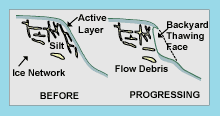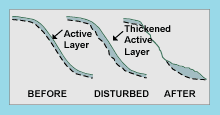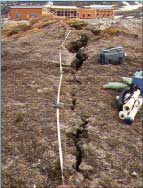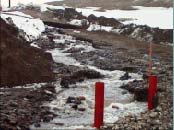
Natural Resources Canada > Earth Sciences Sector > Priorities > Climate Change Impacts and Adaptation > Climate Change in Canada
Degrees of Variation : Climate change in Nunavut Northern landscapes
Permafrost and climate change...
Changes in the permafrost will depend on the type of subsurface material and its temperature, as well as on local ground-ice conditions. Warming will likely cause a deepening of the summer thaw layer (active layer), resulting in unstable soils and settlement of the ground surface. In more southern regions, large areas of permafrost may actually disappear. The greatest impacts from these changes will probably be increased slope movement and changes to soil properties.

Excavator uncovers ground-ice, Pond Inlet
(James A. (Drew) Hyatt) |
Permafrost...
In the North, permafrost or frozen ground is one of the most important features controlling physical changes on the land. Permafrost is found beneath the ground surface in nearly all of Nunavut and some of this permafrost, especially in lowland areas, contains high amounts of ground-ice.
Did you know?
The permafrost boundary is expected to move north by several hundred kilometers.
Slope instability...
Thaw flows and active layer detachments can result from warmer summer temperatures and heavy precipitation events. These slides can alter the landscape and are a potential threat to infrastructure and natural habitats.

Thaw flow, Fosheim Peninsula
(S.D. Robinson) |

(A.G. Lewkowicz) |

Cross-section thaw flow slide
(Adapted from: N.W. Rutter) |

Cross-section active-layer detachment
(Adapted from: N.W. Rutter) |
Impacts on infrastructure...

Crack caused by growth of a frost blister, Pangnirtung
(James A. (Drew) Hyatt) |
Melting of permafrost would have a major impact on infrastructure. Warmer temperatures would reduce the stability and strength of the land. Sinking of the ground surface from permafrost thaw could become severe. This could threaten the structural integrity of older buildings, water supplies and waste disposal structures.
Impact on industry...
In warmer areas, placer and open-pit mining would be easier because permafrost would be reduced. Warmer temperatures would also mean the strength of soil would be reduced and underground mines would see an increased risk of rock falls and flooding.

New houses are built on pilings or bedrock to
minimize permafrost impacts
(K. Parlee, GSC 2000-059A) |
Did you know?
Permafrost forms an impermeable layer for mine tailings and landfill sites. A loss of this layer could increase the risk of contamination to soil and water.
Impact on transportation...

Runoff from snow melt washes out road; Iqaluit
(K. Parlee, GSC 20000-058B) |
Increased shoreline erosion may lead to more sediment along the coast, creating navigational hazards for shipping. Reduced ground stability may also affect roads and runways, and make summer overland travel more difficult.
Did you know?
Warmer temperatures will thaw traditional ice cellars making them useless for storing meat.
| 